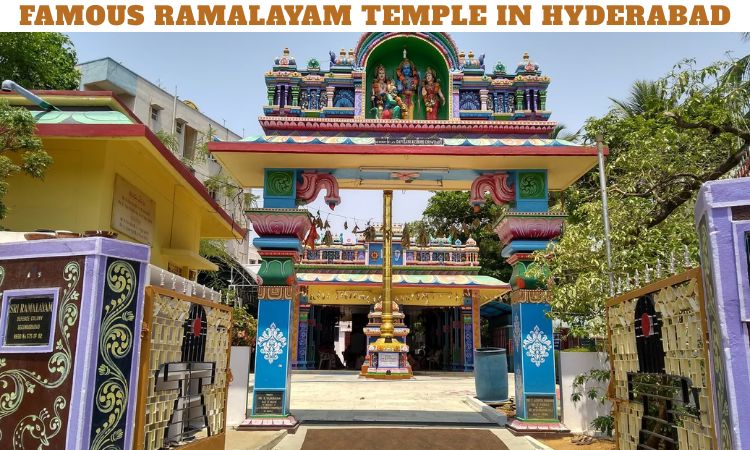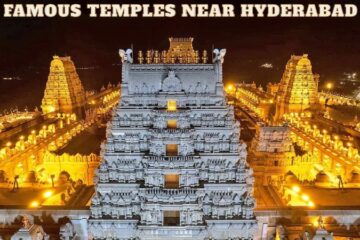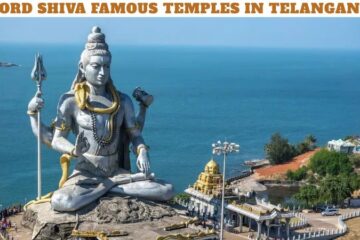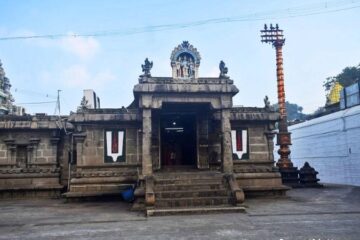
Table of Contents
Hyderabad, the bustling capital of Telangana, is a city where ancient traditions beautifully intertwine with modern dynamism. Amidst its towering skyscrapers and burgeoning IT hubs, lie numerous spiritual sanctuaries that serve as quiet havens for devotees and architectural marvels for enthusiasts. Among these, one temple stands out for its profound spiritual significance, captivating history, and architectural grandeur: the famous Ramalayam Temple in Hyderabad. More than just a place of worship, this temple is a living testament to faith, a repository of cultural heritage, and a vibrant center for community life, drawing thousands of devotees annually from across the region and beyond.
A Glimpse into History: The Genesis of Devotion
The origins of the famous Ramalayam Temple in Hyderabad are steeped in local lore and historical accounts, though precise founding dates can sometimes be elusive, as is common with many ancient Indian temples. What is widely accepted is that the temple has stood for several decades, if not longer, evolving from a humble shrine into the magnificent complex it is today. Dedicated primarily to Lord Rama, an incarnation of Vishnu, and his consort Sita, along with Lakshmana and Hanuman, the temple embodies the deep reverence for the Ramayana epic that permeates Indian culture.
Local narratives often speak of a devout visionary or a group of dedicated individuals who, moved by their unwavering faith in Lord Rama, initiated the construction of this sacred space. Over the years, through the collective efforts of devotees, philanthropists, and successive generations of temple management, the Ramalayam Temple has undergone several expansions and renovations, each adding to its splendor and capacity to accommodate the growing number of pilgrims. These continuous efforts reflect the community’s enduring commitment to preserving and enhancing this spiritual landmark. The temple’s history is not merely a chronicle of construction but also a narrative of unwavering devotion, communal harmony, and the perpetuation of timeless spiritual practices.
Architectural Grandeur: A Symphony in Stone
The architecture of the famous Ramalayam Temple in Hyderabad is a captivating blend of traditional South Indian temple styles, infused with elements that reflect local craftsmanship. As one approaches the temple, the towering gopuram (ornate gateway tower) often captures immediate attention, adorned with intricate carvings of deities, mythological figures, and celestial beings. This gopuram serves not only as an entrance but also as a symbolic representation of the spiritual journey one undertakes upon entering the sacred precincts.
The main sanctum, housing the principal deities, is typically constructed with sturdy stone, often granite, known for its durability and aesthetic appeal. The walls of the temple are frequently embellished with exquisite sculptures depicting scenes from the Ramayana, the Mahabharata, and other Hindu scriptures. These carvings are not merely decorative; they serve as visual narratives, educating devotees about ancient tales of dharma, valor, and devotion. The pillars within the temple complex are often intricately carved, showcasing the skill of artisans who dedicated their lives to religious art. The mandapams (halls) within the temple are designed to accommodate large congregations during festivals and ceremonies, with their high ceilings and spacious layouts contributing to an atmosphere of reverence and peace. The use of natural light and ventilation is also a hallmark of traditional temple architecture, ensuring a comfortable and spiritually uplifting environment. The overall design of the famous Ramalayam Temple in Hyderabad reflects a deep understanding of sacred geometry and Vastu Shastra, principles that guide the harmonious alignment of structures with cosmic energies.
Deities and Daily Devotion: The Heartbeat of the Temple
At the spiritual core of the famous Ramalayam Temple in Hyderabad are the beautifully adorned idols of Lord Rama, Sita Devi, Lakshmana, and Hanuman. These deities are not merely statues but are revered as living manifestations of the divine, imbued with immense spiritual power. The idols are meticulously crafted, often from black stone or marble, and are regularly bathed, dressed in vibrant silks, and adorned with exquisite jewelry and fresh flowers, a ritual known as abhishekam and alankaram.
Daily rituals (pujas) are performed with utmost devotion by the temple priests, beginning early in the morning with Suprabhatham (waking up the deities) and continuing throughout the day with various offerings, chanting of mantras, and aarti (waving of lamps). Devotees participate in these rituals, offering prayers, lighting lamps, and seeking blessings. The serene atmosphere, coupled with the rhythmic chanting and the fragrance of incense, creates a deeply meditative experience. Special archanas (individual prayers) and homams (fire rituals) are also conducted for devotees seeking specific blessings or spiritual purification. The presence of Hanuman, the ardent devotee of Rama, is particularly significant, as he is revered for his strength, loyalty, and ability to overcome obstacles. Many devotees visit the temple specifically to offer prayers to Hanuman, believing he can grant courage and protection.
Festivals and Celebrations: A Kaleidoscope of Devotion
The famous Ramalayam Temple in Hyderabad truly comes alive during its annual festivals, transforming into a vibrant hub of celebration and communal joy. The most significant of these is undoubtedly Ram Navami, the birthday of Lord Rama. This festival is celebrated with immense fervor, drawing tens of thousands of devotees. The temple organizes elaborate processions, special kalyanotsavam (celestial wedding ceremony of Rama and Sita), cultural programs, and spiritual discourses. The air resonates with devotional songs (bhajans) and chants of “Jai Shri Ram,” creating an electrifying atmosphere of collective devotion.
Other major festivals celebrated with great enthusiasm include Diwali, the festival of lights, which symbolizes Rama’s return to Ayodhya; Hanuman Jayanti, celebrating the birth of Lord Hanuman; and Dussehra, commemorating Rama’s victory over the demon king Ravana. During these times, the temple premises are beautifully decorated with lights, flowers, and traditional motifs. Special food offerings (prasadam) are prepared and distributed to all devotees, embodying the spirit of sharing and community. These festivals are not just religious observances but also significant cultural events that bring people together, fostering a sense of unity and shared heritage. The temple management often arranges for cultural performances, including classical music and dance, further enriching the festive experience.
Spiritual Resonance and Pilgrimage: A Haven for the Soul
For countless devotees, the famous Ramalayam Temple in Hyderabad is more than just a place of worship; it is a profound spiritual anchor. It offers a sanctuary from the stresses of daily life, a place where one can connect with the divine, seek solace, and find inner peace. The vibrations within the temple, generated by centuries of devotion and continuous chanting, are said to be deeply calming and spiritually uplifting. Pilgrims visit the temple to offer thanks for blessings received, to seek guidance during challenging times, or simply to immerse themselves in an atmosphere of pure devotion.
The temple also plays a crucial role in fostering spiritual education. Discourses on the Ramayana, Bhagavad Gita, and other scriptures are regularly held, providing insights into Hindu philosophy and ethical living. These sessions are attended by people of all ages, eager to deepen their understanding of spiritual principles. The temple serves as a reminder of the timeless values of righteousness (dharma), devotion (bhakti), and selfless service (seva) that Lord Rama embodies. It is a place where faith is rekindled, hopes are renewed, and the soul finds its true calling. The journey to the famous Ramalayam Temple in Hyderabad is often considered a pilgrimage, a sacred quest for spiritual fulfillment.
Community and Cultural Hub: More Than Just a Temple
Beyond its primary role as a place of worship, the famous Ramalayam Temple in Hyderabad functions as a vital community and cultural hub. It often organizes various social and charitable activities, reflecting the Hindu principle of seva (selfless service). These may include feeding the poor, conducting health camps, providing educational support, or offering assistance during natural calamities. Such initiatives underscore the temple’s commitment to societal welfare and its role as a compassionate institution.
The temple also actively promotes and preserves traditional arts and culture. It serves as a venue for classical music concerts, dance performances, and religious dramas, providing a platform for artists and enriching the cultural landscape of the city. Children are often encouraged to participate in cultural and spiritual activities, ensuring that the rich traditions are passed down to future generations. The temple premises often include facilities like a goshala (cow shelter), a library of spiritual texts, and community halls, further enhancing its utility as a multi-faceted institution. It is a place where people from diverse backgrounds come together, transcending social barriers in their shared devotion.
Planning Your Visit: Essential Information
For those planning to experience the spiritual aura of the famous Ramalayam Temple in Hyderabad, here is some practical information:
-
Location: The temple is strategically located within Hyderabad, making it accessible from various parts of the city. It’s advisable to use GPS or inquire locally for the most precise directions, as Hyderabad’s road network can be complex.
-
Timings: Most temples in India have specific opening and closing hours, with breaks during the afternoon. It’s best to check the current timings before your visit, especially for darshan (viewing of the deities) and aarti timings.
-
Dress Code: While there isn’t usually a strict dress code, it is respectful to dress modestly, covering shoulders and knees, as is customary in Indian temples.
-
Photography: Inquire at the temple premises regarding photography rules. Some areas might restrict photography to maintain sanctity.
-
Accessibility: The temple is generally well-maintained, but visitors with mobility issues might want to check for specific accessibility features.
-
Footwear: As with all Indian temples, footwear must be removed before entering the main temple complex. Designated shoe-keeping areas are usually available.
Conclusion: An Enduring Legacy of Faith
The famous Ramalayam Temple in Hyderabad stands as a magnificent emblem of faith, devotion, and cultural heritage. Its serene ambiance, intricate architecture, and vibrant spiritual activities offer a profound experience for every visitor. From its historical roots to its role as a contemporary community hub, the temple continues to inspire and uplift countless lives. It is a place where ancient traditions are honored, spiritual wisdom is imparted, and the timeless narrative of Lord Rama resonates deeply within the hearts of devotees. A visit to this sacred sanctuary is not merely a sightseeing excursion but a journey into the spiritual heart of Hyderabad, leaving one with a sense of peace, reverence, and a deeper connection to the rich tapestry of Indian spirituality. Its enduring legacy ensures that it will remain a beacon of faith for generations to come.
Frequently Asked Questions (FAQs)
1. What is the famous Ramalayam Temple in Hyderabad primarily dedicated to?
Ans. The temple is primarily dedicated to Lord Rama, an incarnation of Vishnu, and his consort Sita, along with Lakshmana and Hanuman.
2. What is known about the origins of the Ramalayam Temple?
Ans. The temple’s origins are steeped in local lore and historical accounts, evolving from a humble shrine. It is widely accepted that it has stood for several decades, if not longer, through the efforts of devout individuals, philanthropists, and successive generations.
3. What are the key architectural features of the Ramalayam Temple?
Ans. The temple showcases a blend of traditional South Indian temple styles. Key features include a towering gopuram (ornate gateway tower), main sanctums built with sturdy stone (often granite), walls embellished with exquisite sculptures from Hindu scriptures, intricately carved pillars, and spacious mandapams (halls).
4. Which deities are housed in the main sanctum of the Ramalayam Temple?
Ans. The main sanctum houses the beautifully adorned idols of Lord Rama, Sita Devi, Lakshmana, and Hanuman.
5. What daily rituals are performed at the temple?
Ans. Daily rituals (pujas) include Suprabhatham (waking up the deities) early in the morning, various offerings, chanting of mantras, and aarti (waving of lamps) throughout the day. Special archanas and homams are also conducted.
6. What is the most significant festival celebrated at the Ramalayam Temple?
Ans. The most significant festival is Ram Navami, the birthday of Lord Rama, celebrated with elaborate processions, kalyanotsavam (celestial wedding ceremony), cultural programs, and spiritual discourses.
7. Besides Ram Navami, what other major festivals are celebrated with enthusiasm?
Ans. Other major festivals include Diwali, Hanuman Jayanti, and Dussehra.
8. How does the temple contribute to spiritual education?
Ans. The temple regularly holds discourses on the Ramayana, Bhagavad Gita, and other scriptures, providing insights into Hindu philosophy and ethical living.
9. In what ways does the Ramalayam Temple function as a community and cultural hub?
Ans. Beyond worship, it organizes social and charitable activities (like feeding the poor, health camps), promotes traditional arts and culture through concerts and performances, and often includes facilities like a goshala, library, and community halls.
10. What is the recommended dress code for visiting the temple?
Ans. While not strictly enforced, it is respectful to dress modestly, covering shoulders and knees, as is customary in Indian temples. Footwear must be removed before entering the main complex.


